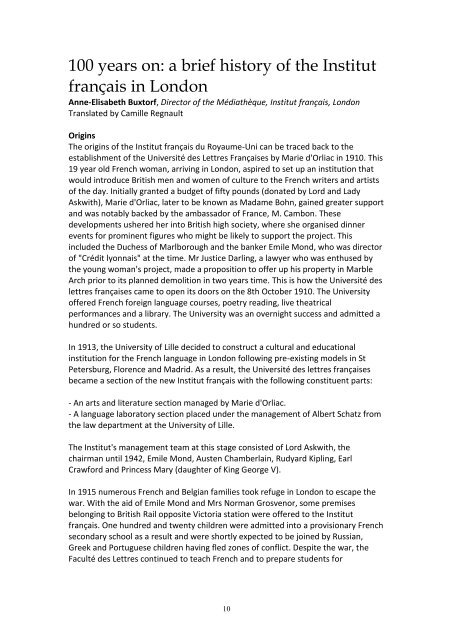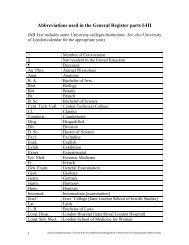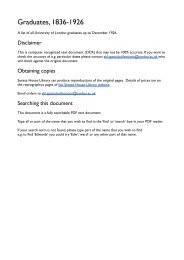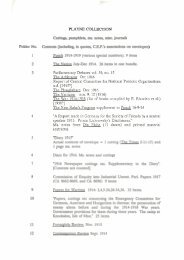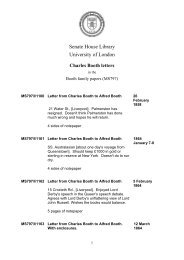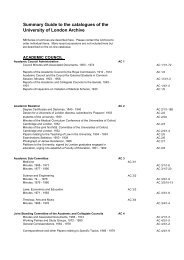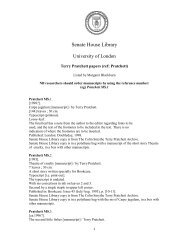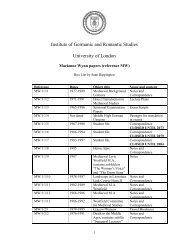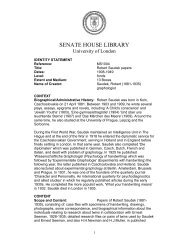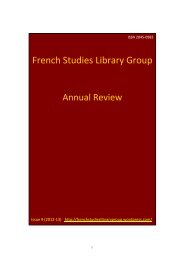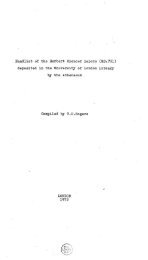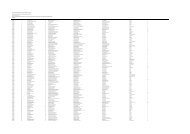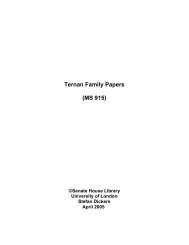FSLG Annual Review - Senate House Libraries - University of London
FSLG Annual Review - Senate House Libraries - University of London
FSLG Annual Review - Senate House Libraries - University of London
You also want an ePaper? Increase the reach of your titles
YUMPU automatically turns print PDFs into web optimized ePapers that Google loves.
100 years on: a brief history <strong>of</strong> the Institut<br />
français in <strong>London</strong><br />
Anne-Elisabeth Buxtorf, Director <strong>of</strong> the Médiathèque, Institut français, <strong>London</strong><br />
Translated by Camille Regnault<br />
Origins<br />
The origins <strong>of</strong> the Institut français du Royaume-Uni can be traced back to the<br />
establishment <strong>of</strong> the Université des Lettres Françaises by Marie d'Orliac in 1910. This<br />
19 year old French woman, arriving in <strong>London</strong>, aspired to set up an institution that<br />
would introduce British men and women <strong>of</strong> culture to the French writers and artists<br />
<strong>of</strong> the day. Initially granted a budget <strong>of</strong> fifty pounds (donated by Lord and Lady<br />
Askwith), Marie d'Orliac, later to be known as Madame Bohn, gained greater support<br />
and was notably backed by the ambassador <strong>of</strong> France, M. Cambon. These<br />
developments ushered her into British high society, where she organised dinner<br />
events for prominent figures who might be likely to support the project. This<br />
included the Duchess <strong>of</strong> Marlborough and the banker Emile Mond, who was director<br />
<strong>of</strong> "Crédit lyonnais" at the time. Mr Justice Darling, a lawyer who was enthused by<br />
the young woman's project, made a proposition to <strong>of</strong>fer up his property in Marble<br />
Arch prior to its planned demolition in two years time. This is how the Université des<br />
lettres françaises came to open its doors on the 8th October 1910. The <strong>University</strong><br />
<strong>of</strong>fered French foreign language courses, poetry reading, live theatrical<br />
performances and a library. The <strong>University</strong> was an overnight success and admitted a<br />
hundred or so students.<br />
In 1913, the <strong>University</strong> <strong>of</strong> Lille decided to construct a cultural and educational<br />
institution for the French language in <strong>London</strong> following pre-existing models in St<br />
Petersburg, Florence and Madrid. As a result, the Université des lettres françaises<br />
became a section <strong>of</strong> the new Institut français with the following constituent parts:<br />
- An arts and literature section managed by Marie d'Orliac.<br />
- A language laboratory section placed under the management <strong>of</strong> Albert Schatz from<br />
the law department at the <strong>University</strong> <strong>of</strong> Lille.<br />
The Institut's management team at this stage consisted <strong>of</strong> Lord Askwith, the<br />
chairman until 1942, Emile Mond, Austen Chamberlain, Rudyard Kipling, Earl<br />
Crawford and Princess Mary (daughter <strong>of</strong> King George V).<br />
In 1915 numerous French and Belgian families took refuge in <strong>London</strong> to escape the<br />
war. With the aid <strong>of</strong> Emile Mond and Mrs Norman Grosvenor, some premises<br />
belonging to British Rail opposite Victoria station were <strong>of</strong>fered to the Institut<br />
français. One hundred and twenty children were admitted into a provisionary French<br />
secondary school as a result and were shortly expected to be joined by Russian,<br />
Greek and Portuguese children having fled zones <strong>of</strong> conflict. Despite the war, the<br />
Faculté des Lettres continued to teach French and to prepare students for<br />
10


